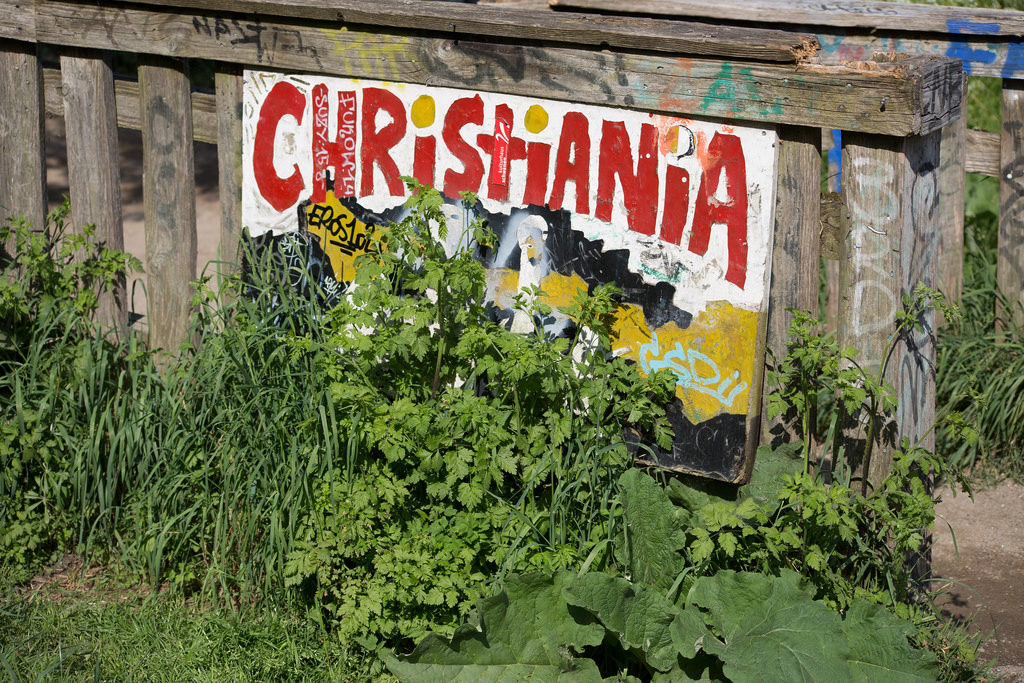Christiania, one of Copenhagen’s most iconic tourist attractions, is on the cusp of a major makeover. The semi-autonomous “Free town” of Christiania sits nestled in the heart of central Copenhagen on an old military base and is most famous for Pusher Street and its Green Light District where Hash and Marijuana are openly sold despite being illegal in Denmark. The story goes that a group of hippy squatters moved into the base in the 70s and took it over. Since it started Christiania has been largely left alone and currently serves as home to roughly 900 people living in a self governed democracy.
In recent years there has been increasing pressure for Christiania to re-integrate. In part, this has been due to an increase in crime tied to Christiania’s famous “Pusher Street” as the vendors have pivoted from casual and friendly sales by local residents, to gangs and outside groups eager to peddle harder wares and who have an inclination towards violence. Added semi-frequent raids by the Copenhagen police have only served to further the divide.
Over the last few years there has been an uneasy truce. Police would periodically raid Christiania, or set up stop-and-search stations in the nearby Christianshavn metro station, but would otherwise largely leave Christiania alone. The aim has been to focus on driving re-integration through economic and political means by working to normalize the free town, working with its leadership, without stripping away much of what has made the community special.
All of this changed August 31st when two police officers and a civilian were shot by an armed dealer mid-arrest. The dealer was later shot and killed. At the heart of Christiania and Pusher Street there has always been a simple unwritten rule: No guns and no violence. It is part of what has differentiated Christiania and made it stand out as an exciting and welcoming experiment. A casual hippie free town, that focuses on artistry, quirks and living daily life, Christiania has always been a safe place, full of families, and which served as a crossroads between people from all different backgrounds and trades from bankers to boat hands, CEOs to young children and their families.
Pusher Street, Perhaps this is Goodbye
By September 2nd the community called a meeting and made a surprising, but significant decision; enough was enough, and Pusher Street would be closed. In a post to Facebook the community expressed their sadness for the violence and went on to state (translated from Danish):
“We can take away the shops, but we can’t make sure that they stay closed and do not re open. To do this we need the support and help from all of Denmark and one way that can help is if you do not buy hash out here.”
Shortly after posting the message and asking tourists and locals alike to stop supporting the Weed and Hash market, the community came together to strip all of the stands out of Pusher Street. This is a significant development and change and may be the final nail in the coffin for Pusher Street.
What comes next is uncertain. During past raids Police have removed the stalls, which normally re-appear within a few days. However, this is the first time that the community has gone in and done it themselves which may also pave the way for an active and regular police presence used to permanently shut down Pusher Street.
It’s also still to be seen what the impact of de-centralizing the sale of hash and marijuana will have on the city. The market has served as a centralized distribution location for years and kept street dealers out of neighborhoods, parks and common areas. A push 10 years ago to shut down the district led to dealers flooding into neighborhoods, parks and transit stations. A trend we’re already starting to see repeat itself.
Others are hopeful that the removal of Pusher Street will trigger an increased willingness to go to the source of the issue and to drive political will to start discussing legalization similar to what we’ve seen in the United States and other areas of Europe.
The Real Christiania
It’s important to note that it’s not Christiania that’s been closed. The free town has best known for Pusher Street and Nemoland, and that’s the part that most tourists see, however there’s much, much more to the area.
Christiania is home to a wide variety of cozy restaurants, coffee shops, and cozy music venues. There are wonderful artisan spaces and you’ll even find a stables and a bathhouse. Of course, there’s also the free-town’s quirky mixture of zoning-free houses and eclectic schools all which serve as a reminder that Christiania is much more than just another place to buy a join.
While it’s difficult to chart what Christiania’s future looks like, it seems that the free town has hit a critical tipping point. If you’re planning a visit to Copenhagen soon, make sure to check in, just don’t expect the Christiania you read in your guide book to be the same one you find upon arrival.
You can view my November, 2015 Denmark 101 video where I talked about the rapidly changing face of Christiania here.
EDIT / Update – September 26th
A few weeks have passed since I initially made this post. Here are a few of the latest updates:
- The police have been invited to install video cameras along Pusher’s Street
- Apparently some sales are still occurring and tolerated, but only from locals/residents – not the organized groups/gangs that had set up shop previously
- It does look like Pusher’s Street as it has been over the last 5-10 years is done for. However, it looks like there is the possibility that it returns to how it was historically.
